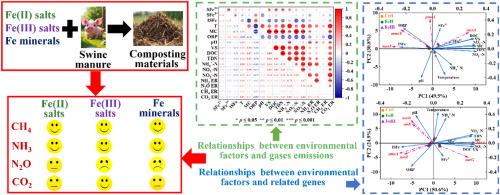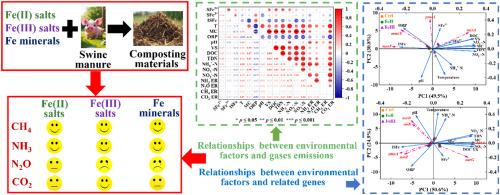Effects of iron on greenhouse gases and ammonia emissions and related genes in swine manure composting
IF 10
1区 环境科学与生态学
Q1 ENGINEERING, ENVIRONMENTAL
引用次数: 0
Abstract
Greenhouse gases (GHGs) and ammonia (NH3) emissions from livestock and poultry manure composting are a crucial environmental problem worldwide. In this study, effects of ten soluble iron (Fe) salts or insoluble Fe and Fe minerals on carbon dioxide (CO2), methane (CH4), nitrous oxide (N2O) and NH3 emissions were systematically explored in swine manure composting, respectively. Results illustrated that soluble Fe salts were superior to insoluble Fe minerals on reducing global warming potential (GWP) of GHGs. Furthermore, Fe(Ⅲ) salts were more effective on weakening CH4, NH3 and CO2 emissions compared to Fe(Ⅱ) salts. Specifically, 35.7 % and 67.3 % of CH4 reduction was attributed that ferrous chloride (FeCl2) and ferric chloride (FeCl3) increased initial oxidation reduction potential (ORP) and mitigated mmoX and pmoA downward in initial composting. Abundances of mmoX and pmoA decreased by 45.9 % and 76.3 % in Ctrl treatment, 37.9 % and 60.7 % in FeⅡ treatment, 25.7 % and 51.9 % in FeⅢ treatment, respectively. In addition, main methanogenic archaea of Methanobrevibacter abundances in Ctrl, FeⅡ and FeⅢ obviously decreased by 82.2 %, 89.3 % and 92.2 % in the first 10 days, respectively. Moreover, Fe(Ⅲ) salts enhanced N2O emission relative to Ctrl and Fe(Ⅱ) salts. NH4+-N content, nirK and norB increment might promote N2O release in initial period. Notedly, nosZ of Ctrl and FeⅡ separately ascended by 71.2 % and 66.9 %, yet nosZ of FeⅢ descended by 45.8 % in the first 10 days, which might restrict denitrification. Generally, this study proposed a valuable and feasible strategy to alleviate GHGs emissions and nitrogen loss in composting.


铁对猪粪堆肥温室气体和氨排放的影响及相关基因研究
畜禽粪便堆肥产生的温室气体(ghg)和氨(NH3)排放是世界范围内的一个重要环境问题。本研究系统探讨了10种可溶性铁(Fe)盐或不溶性铁及铁矿物对猪粪堆肥中二氧化碳(CO2)、甲烷(CH4)、氧化亚氮(N2O)和NH3排放的影响。结果表明,可溶性铁盐对降低温室气体全球变暖潜势(GWP)的作用优于不溶性铁矿物。此外,Fe(Ⅲ)盐比Fe(Ⅱ)盐更有效地减弱CH4、NH3和CO2的排放。具体来说,35.7%和67.3%的CH4减少归因于氯化亚铁(FeCl2)和氯化铁(FeCl3)在初始堆肥中增加了初始氧化还原电位(ORP),降低了mmoX和pmoA。mmoX和pmoA丰度在Ctrl处理下分别下降45.9%和76.3%,FeⅡ处理下分别下降37.9%和60.7%,FeⅢ处理下分别下降25.7%和51.9%。另外,产甲烷细菌中主要产甲烷古菌的丰度在前10 d内分别显著下降82.2%、89.3%和92.2%。此外,相对于Ctrl和Fe(Ⅱ)盐,Fe(Ⅲ)盐增强了N2O排放。NH4+-N含量、nirK和norB的增加可能促进初期N2O的释放。值得注意的是,Ctrl和FeⅡ的nosZ分别上升了71.2%和66.9%,而FeⅢ的nosZ在前10天下降了45.8%,这可能限制了反硝化作用。综上所述,本研究为减少堆肥过程中温室气体的排放和氮素的流失提供了一个有价值和可行的策略。
本文章由计算机程序翻译,如有差异,请以英文原文为准。
求助全文
约1分钟内获得全文
求助全文
来源期刊

Journal of Cleaner Production
环境科学-工程:环境
CiteScore
20.40
自引率
9.00%
发文量
4720
审稿时长
111 days
期刊介绍:
The Journal of Cleaner Production is an international, transdisciplinary journal that addresses and discusses theoretical and practical Cleaner Production, Environmental, and Sustainability issues. It aims to help societies become more sustainable by focusing on the concept of 'Cleaner Production', which aims at preventing waste production and increasing efficiencies in energy, water, resources, and human capital use. The journal serves as a platform for corporations, governments, education institutions, regions, and societies to engage in discussions and research related to Cleaner Production, environmental, and sustainability practices.
 求助内容:
求助内容: 应助结果提醒方式:
应助结果提醒方式:


